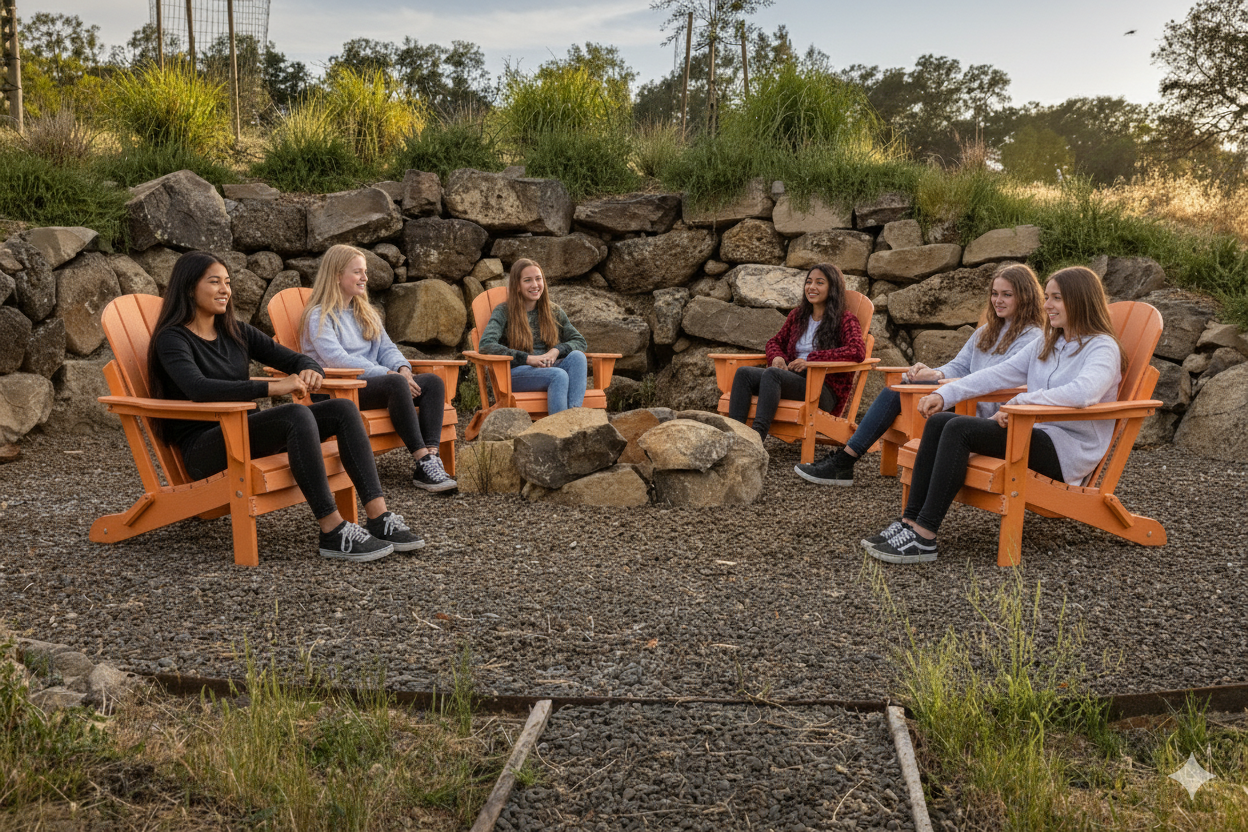A-CRA reduces or eliminates substance abuse by increasing positive reinforcers for teens in areas of their lives related to family, social relationships, jobs and educational resources. By using A-CRA in treatment, teen boys are equipped with the tools they need to lead healthy, happy lives without depending on alcohol or drugs.
Explaining the CRA Model
The Adolescent Community Reinforcement Approach is a variation of the adult Community Reinforcement Approach, which strives to eliminate positive reinforcement for drug or alcohol use and increase positive reinforcement for healthy, non-chemical dependent activities. CRA works by replacing environmental factors that support drug or alcohol use with prosocial activities and behaviors that support recovery. These prosocial behaviors may include organized sports, physical activities and outdoor adventures, volunteer activities, or religious activities. Muir Wood’s Adventure Therapy program is an example of how we integrate CRA techniques into our treatment program for teen boys.
CRA also uses therapy sessions with role-playing and homework assignments to help addicted individuals find healthier ways to cope with life’s challenges while learning to enjoy life without drugs or alcohol.
For teens, the Adolescent Community Reinforcement Approach builds upon the Community Reinforcement Approach by also including therapy sessions with family and caregivers in the treatment process. These therapy sessions are both individual family therapy sessions and group sessions with the teen and his caregivers.
What The Adolescent Community Reinforcement Approach Includes
A-CRA incorporates three types of therapy sessions in an all-encompassing approach to recovery. The therapy sessions include appointments with adolescents alone, parents/caregivers alone, and sessions with teens and parents/caregivers together. By employing a three-pronged approach, A-CRA strengthens teens in their recovery by offering positive reinforcement on all sides and building individual skills as well as improves relationships with family members and others.
In A-CRA, therapists choose from 17 A-CRA procedures that address areas that each individual needs help with, ranging from problem-solving skills to anger management to communication skills.
To begin A-CRA, therapists assess each adolescent and also ask the client questions to gather a self-assessment of happiness in different areas of life. From these assessments, therapists come up with personalized programs to improve areas of a teen’s life that could use some work. For instance, a therapist may determine that problem-solving is difficult for a teen and will give the teen a chance to practice problem-solving skills during sessions.
In therapy sessions, role-playing activities and behavioral rehearsal help teens practice and strengthen their skills in communication, socializing, and turning down the temptation of drugs or alcohol. Practicing skills during therapy and outside of therapy with mutually agreed-upon homework assignments is monumental to a teen’s success in treatment. Homework assignments often include individual skills work as well as participation in prosocial activities such as organized sports, physical activities, volunteering, organized non-sports activities, and religious activities. Muir Wood offers activities like Adventure Therapy, which perfectly complements A-CRA by offering a strong, positive social outlet to combat the temptations of addictions.
Areas of life that the Adult Community Reinforcement Approach can help teen boys improve include:
- Communication skills
- Problem-solving skills
- Refusing drugs/alcohol
- Improving social relationships
- Creating a fulfilling life without drugs or alcohol
- Improving family relationships
- Feeling comfortable talking about feelings
- Learning healthy ways to deal with anger
- Improving schoolwork
- Improving job skills and prospects
- Building upon existing healthy support networks
- Building confidence
A-CRA Study
According to the Center for Substance Abuse Treatment’s (CSAT’s) Cannabis Youth Treatment (CYT) Project, adolescents with addiction issues who underwent A-CRA treatment demonstrated significant improvements in the number of days they were abstinent and the percent of adolescents in recovery in the 12 months following treatment. The study followed five manual treatment models, including A-CRA, and A-CRA was not only successful but also the most cost-effective treatment method.
Target Audience for the Adolescent Community Reinforcement Approach
A-CRA is designed to help 13- to 24-year-olds with addiction problems learn to live fuller, healthier lives without chemical dependence on drugs or alcohol.
A-CRA can also be effective for teaching prosocial skills and decreasing addictions in homeless, street-living youth. According to a study published in the June 2007 issue of Addictive Behaviors, among street-living young people ages 14-22 who were recruited for drop-in center treatments, those who were treated with A-CRA demonstrated significantly less substance use than those who were given treatment as usual, and those in the A-CRA group also exhibited increased social stability. A-CRA helps homeless teens improve their social skills by teaching and building upon prosocial behaviors and decreasing anti-social, destructive behaviors.
History of A-CRA
The Adolescent Community Reinforcement Approach is an offshoot of the Community Reinforcement Approach, which was introduced by Hunt and Azrin in 1973. Hunt and Azrin created CRA to try to restructure an alcoholic’s lifestyle and make a sober life more rewarding than one ruled by alcohol. CRA is based on the central tenet that social and occupational settings play a major role in an individual’s recovery from addiction. CRA therefore strives to improve and build upon an individual’s family, social, and educational/vocational environment.
CRA is a cognitive behavioral treatment method that strives to change the environmental factors that facilitate drug or alcohol addiction and abuse. By building and creating pro-social behavior and tools, CRA works to give individuals control over their lives and experience fulfillment and happiness without alcohol or drug dependence.
Since its founding in 1973, CRA has expanded beyond the realm of treating alcoholism to include other drug addictions as well. In the early 1990s, the CRA expanded to include adolescents. The Adolescent Community Reinforcement Approach began, offering treatment to people ages 18 years old and younger. The A-CRA method differs from the adult CRA approach in that it also incorporates a teen’s parents or caregivers in treatment.
Thirty-two sites in fourteen states currently use A-CRA as part of an ongoing Center for Substance Abuse Treatment/Assertive Adolescent Family Treatment initiative. An estimated 2,000 youth have received the intervention since 1998, according to the Substance Abuse and Mental Health Services Administration.
How A-CRA Can Help Teen Boys
Teenage boys face a litany of challenges during a rapidly changing and confusing time in life, and A-CRA helps addicted teen boys refocus their lives and energy into positive, healthy outlets that replace destructive, addictive behaviors.
A-CRA therapists help boys identify the negative and destructive effects that drinking or drug use have on their lives, and actively work on ways to reduce addictive behaviors and build up positive, pro-social behaviors instead.
In A-CRA, therapists work with each individual teen to focus on the positive areas of life that can help them overcome the addictive behavior. A-CRA therapists guide teens to help them build upon areas in their lives that are lacking. Through organized activities like outdoor adventure therapy, Muir Wood helps teen boys construct strong social skills while allowing them to enjoy life in sober and healthy ways. Muir Wood also incorporates family and caregivers in the recovery process of A-CRA, building a strong foundation for teen boys and helping them to address and improve difficult and complicated areas of life while also educating family members and giving them the tools they need to assist in the recovery process.
Benefits of the Adolescent Community Reinforcement Approach for teen boys include:
- Stronger communication skills
- Improved social skills
- Increased prosocial activities
- Decreased reliance on drugs and alcohol
- Healthier relationships
- Improved mood and enjoyment of life
- Decrease in anger issues and communication problems
Co-Occurring Disorders
By offering a thorough assessment and treatment approach, A-CRA also gives therapists an opportunity to diagnose and treat co-occurring disorders in teen boys.
Teens who suffer from mood disorders, personality disorders and other mental health disorders are at an increased risk of developing addictions, and assessing these teens in A-CRA therapy provides a chance to spot co-occurring disorders that need to be addressed. Diagnosing these disorders allows Muir Wood to create the most comprehensive treatment program to reduce and eliminate risk factors contributing to a teen boy’s alcohol or drug addiction.
Therapy Options
 Muir Wood offers a wide range of therapy options to help teen boys suffering from addictions overcome their destructive, addictive behavior and go on to lead happy, fulfilled lives. Muir Wood’s programs ensure that your son gets the full treatment experience he needs for a lasting recovery. We offer adventure therapy, both forms of pro-social behavior, comprehensive family therapy, and group therapy.
Muir Wood offers a wide range of therapy options to help teen boys suffering from addictions overcome their destructive, addictive behavior and go on to lead happy, fulfilled lives. Muir Wood’s programs ensure that your son gets the full treatment experience he needs for a lasting recovery. We offer adventure therapy, both forms of pro-social behavior, comprehensive family therapy, and group therapy.
In the event a therapist suspects other disorders are present in your son during treatment, we also offer thorough psychological testing to help your son get the assistance he needs to make a full recovery and transition into a fulfilled sober life. Our thorough treatment approach guarantees that your son gets the best personalized, all-encompassing therapy he needs to become a happy and healthy member of society.
Get Help for Your Son
For more information on the Adolescent Community Reinforcement Approach and how it can be used in your son’s addiction treatment, or for information on how your son can make a full recovery from alcoholism or drug addiction, call us here at Muir Wood.








